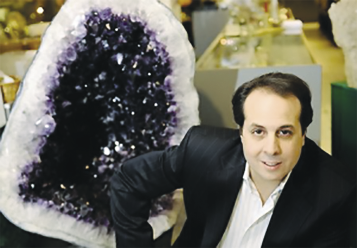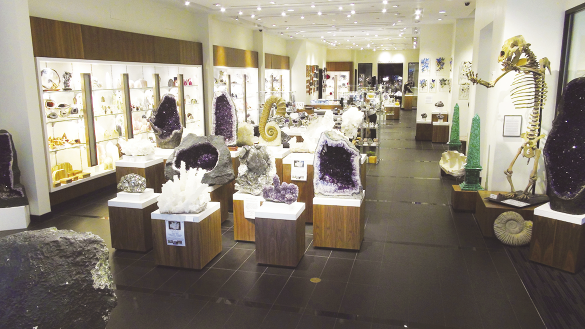- Home
- Media Kit
- Current Issue
- Past Issues
- Ad Specs-Submission
- Ad Print Settings
- Reprints (PDF)
- Photo Specifications (PDF)
- Contact Us


![]()
ONLINE


Dennis Tanjeloff in front of a 2,000-pound amethyst geode
Minerals, Fossils, and Gems
Editors’ Note
Dennis Tanjeloff has been involved in the family business since the age of four, when his grandfather began to bring the young boy with him to find, buy, and sell minerals, gems, fossils, and related objects of art for the company. By his teenage years, he began to take a more formal role at Astro, working summers and weekends at the gallery. By 2004, Tanjeloff had taken the helm and reinvented Astro Gallery from a retail gallery to a worldwide mineralogical powerhouse. Not one to rest on his laurels, in recent years, he has participated in several ventures as both an active and silent partner, including AV Source NY, a leading smart home design and installation firm.
Company Brief
Considered one of the world’s largest and most established gem and mineral galleries, Astro Gallery of Gems (astrogallery.com) is located in the heart of New York City across from The Empire State Building. Their 10,000-square-foot showroom has thousands of minerals, gems, fossils, and pieces of rare and unusual jewelry on display. They carry specimens suitable for the novice as well as the most advanced collector, and they have everything from tumbled stones to 2,000-pound amethyst geodes.
How has the business evolved for Astro Gallery of Gems?
Astro Gallery of Gems was founded by my grandfather in 1961. In those early days, we were exporters of rough gem material and importers of semi-precious stones from Africa and South America, which we used to wholesale to the European and Chinese markets for lapidary works.
During those years, as the wholesale business grew, my grandfather in 1964 took on a 12,000-square-foot retail gallery space on 34th street between Third and Lexington Avenues, and brought the retail portion of the business to life. He was one of the few pioneers in the hobby of collecting gems, minerals, and fossils as not only decorative pieces but as collectibles.

A mineral display at Astro Gallery of Gems on Fifth Avenue
How have you grown the business?
There are just a few major markets that minerals, gems, and fossils fall into. One market is the decorator with an appreciation of the beauty of nature. Typically, they buy them for clients to have as conversation pieces or just as nature’s works of art.
Another big growth area has been collectors who see them as unique pieces of art. Some pieces are very rare so, as the years go by, they grow in value. We’re well known as a company that trades in this market as well as providing reliable estimates of value.
What range of products do you feature at your new flagship store on Fifth Avenue?
As the company grew, we continued to expand the products we carry. The company has five divisions: we have jewelry, where we deal with sterling silver jewelry with all semi-precious gems as well as 14- and 18-karat gold jewelry with high-end gemstones like rubies, emeralds, sapphires, and other colored stones; we have fossils; we have meteorites; we have seashells and corrals; and our main exhibition is gems and minerals.
How do you define the customer base for these unique products?
When customers come in, they are fascinated by what they see and usually one of their first comments is, I used to have a collection of rocks or fossils when I was a kid.
We saw how excited the children who were coming to the store with their parents became and realized that there was a very large market in educating 3-to-10-year-old children about crystals, gems, and fossils. FAO Schwarz was the logical choice for a retail presence and we created a company called AstroKids that is dedicated just to children. It was launched three years ago and has been one of the most successful retail concepts at FAO. We’re now looking into an additional rollout with the management team from FAO Schwarz as they are now considering an expansion.
There has also been a very large holistic market that has grown over the past two decades. This group is very passionate about the holistic energies of crystals, as well as their feng shui value and their folklore. This interest has a huge worldwide following.
There is also the decorator market, which has seen additional renewed interest and has broadened worldwide.
While some of these are new horizons for Astro, it is the collector and the hobbiest who has powered the massive increase in value of the Rock and Mineral business. The auction houses, such as Heritage and Sotheby’s, have found that this is a new category outside of their traditional Art and Wine offerings, which has been well received and is now found in the finest collections in the world.
For this type of product, can you drive e-commerce or do most customers want to come into the store?
We just started our e-commerce business. I would speculate that on the higher end collectible items, most people would like to come in. This piece will become a part of your home and most people love the experience of coming in and seeing and feeling the piece before they purchase it. This is why the brick-and-mortar concept is much stronger than e-commerce, even though for the low-end merchandise, e-commerce drives tremendous volume.
How challenging is it to find these special pieces?
We have both contemporary minerals and what are called classics. Over the past few centuries, mines have been exhausted and the great mines of yesterday are gone. There is no new supply of any of these classic items that were mined or produced in those mines, so those items have gone up in value tremendously. The only way you can add something of that nature to your collection would be from another collection.
Then there are contemporary finds – things are being discovered in the new worlds of China, inner Mongolia, and some parts of Africa, where exploration is taking place every day and new things are being discovered.
Collectors like to chase these contemporary finds because they’ve seen what has happened over the past few decades with what we call classics, and they feel the upside is huge.
There are more people involved in this as a business today and there are also the hobby-level collectors scouring the world every day for these items. So it not only becomes a challenge just finding the natural resources but also in trying to obtain them. There are bidding wars all over the world for the right finds.
Do you see a value in educating the next generation about these precious pieces?
Not only are we educating new collectors and those who appreciate nature and science, but we’re educating the children in a fun and exciting way.
One of the very reasons FAO partnered with us was our ability to make learning fun. That was very intriguing to the FAO brand and has given them the ability to compete with other science module retail outlets like the Discovery store, the Museum Shop, and other e-commerce sites. I noticed that while parents always want to get their children all the classic toys of the moment, they are also willing to take that extra $100 and invest it in things that are educational.
We created these science products in a fun format that the kids are excited about on their own without being pushed into it, which makes it easy for parents who are very willing to purchase products that capture their children’s interests. We do it in an exciting way where learning takes place outside of the classroom.•